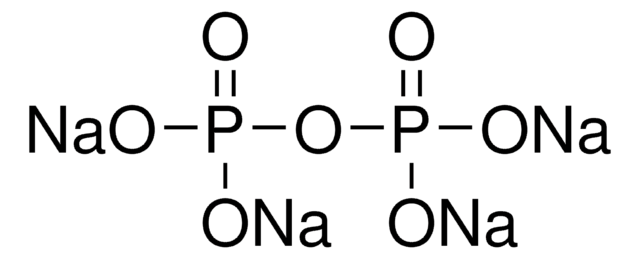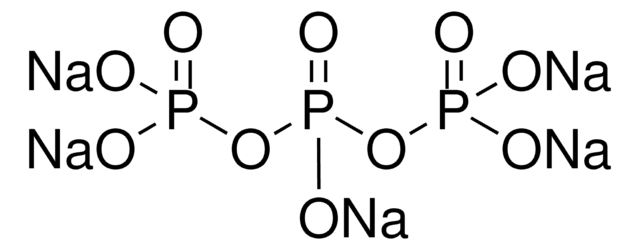S4379
Sodium phosphate glass
Type 45
Iniciar sesiónpara Ver la Fijación de precios por contrato y de la organización
About This Item
Productos recomendados
¿Está buscando productos similares? Visita Guía de comparación de productos
Categorías relacionadas
General description
Sodium phosphate glass is composed of Na2O–P2O5. It is used as a sequestering agent in hard water treatment and also as a dispersant in clay processing and pigment production. In Na-ion batteries, sodium phosphate glass can be used as a solid electrolyte.
Application
Sodium phosphate glass type 45 (polyP45) can be used as a reference material in the extraction and quantification of inorganic polyphosphate residues found in microorganisms.
Biochem/physiol Actions
Reported to be of use in protein binding and sequestering and in studies on bone calcification.
Other Notes
Nan+2PnO3n+1; n = the average number of phosphorus (P) atoms in the chain.
Storage Class
13 - Non Combustible Solids
wgk_germany
WGK 1
flash_point_f
Not applicable
flash_point_c
Not applicable
Elija entre una de las versiones más recientes:
¿Ya tiene este producto?
Encuentre la documentación para los productos que ha comprado recientemente en la Biblioteca de documentos.
Los clientes también vieron
An improved method for extraction and quantification of polyphosphate granules from microbial cells
Mukherjee C and Ray K
Protocol Exchange, 10 (2015)
Fan Zhang et al.
Proceedings of the National Academy of Sciences of the United States of America, 112(14), 4381-4386 (2015-02-26)
Marine sponges are major habitat-forming organisms in coastal benthic communities and have an ancient origin in evolution history. Here, we report significant accumulation of polyphosphate (polyP) granules in three common sponge species of the Caribbean coral reef. The identity of
Harikiran Nistala et al.
Human molecular genetics, 29(21), 3516-3531 (2020-10-27)
Neurodevelopmental disorder with microcephaly, hypotonia and variable brain anomalies (NMIHBA) is an autosomal recessive neurodevelopmental and neurodegenerative disorder characterized by global developmental delay and severe intellectual disability. Microcephaly, progressive cortical atrophy, cerebellar hypoplasia and delayed myelination are neurological hallmarks in
Nuestro equipo de científicos tiene experiencia en todas las áreas de investigación: Ciencias de la vida, Ciencia de los materiales, Síntesis química, Cromatografía, Analítica y muchas otras.
Póngase en contacto con el Servicio técnico







